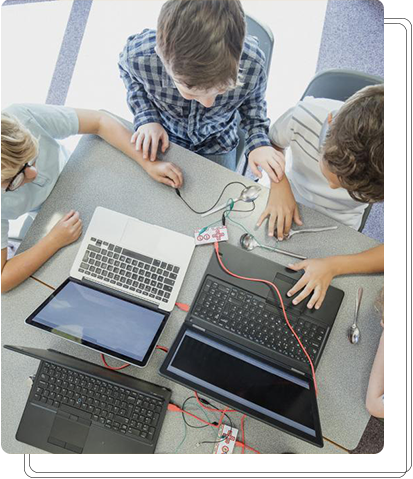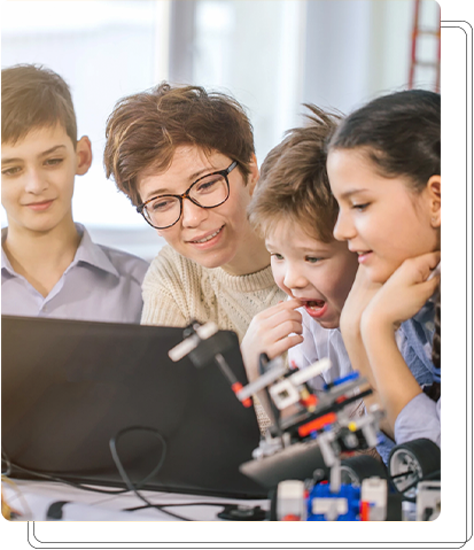Programming for Kids
Block Programming
Block Programming
The world nowadays has found itself in the 4th industrial revolution with the rapid automation of traditional practices, by implementing modern and automated technology which is the fruit of applying coding practices. In our digital world, it is beneficial to know how computers work especially for children which is why it is recommended that they familiarize themselves with coding.
Children can learn from coding to solve problems and develop analytical thinking, the concept of block coding is the easiest to introduce concepts of coding to children due to the ease of understanding and learning.

Block Coding
Block coding is the most elementary form of computer programming and a great way for children to start their programming gateway. Instead of writing complex lines of code, with block coding, children can visualize the coded blocks to create animations and games which I believe is a more effective and attention grabbing method as it also plays to their imagination as well and lays a foundation for computational thinking.
Each block performing a different function on the screen that is moving left, right, forward et cetera being the most basic ones. The visual approach makes programming easier and besides this, the code is also grouped which makes finding issues easier and easily fixable.
Block coding simply uses a drag and drop method and groups of code in the blocks are already loaded. The children select the block and drag it into the input field. They can select another block as well and add it to the existing group of blocks which hones their sense of creation.
Why is block coding important for kids?
Block coding is an introduction to programming activities that develops an interest for children into programming as they develop an insight into how coding works to develop games and animations. It can also increase their computational thinking that is essential in programming.
Coding is the language of our modern digital world therefore it is essential that children understand how our technology obeys our commands which is due to the wonders of programming languages. Furthermore there are some skills that are universally learnt when children tend to code:
- Mathematical skills
- Writing
- Communication
- Creativity
What is Scratch Block Coding?
The first concept of block coding was introduced by MIT in 2003, when they created a basic computer language called Scratch. This form of coding was introduced to children to learn basics of programming. Scratch also gives access to an online community where children can program and people provide interactive media. As children familiarize themselves with programming through Scratch, they tend to collaborate, think creatively and develop reasoning and analytical thinking.
Scratch is specifically designed for people aged 8 to 16 years old, but people of younger age can try ScratchJr. which is a simplified version designed for children aged 4 to 7 years old.
Scratch coding has a library of blocks that allows users to animate cartoon characters called sprites. Sprite can be thought of as a character or an object, thus creating a character is analogous to painting a sprite. Some of the examples of scratch coding are look, motion, sound, pen, video sensing, Lego blocks.


Children and block coding with Scratch
Using Scratch coding blocks is a fun and interactive way for children to develop their programming skills as children have the easily and rapidly access that can bring their imagination to life.
The most efficient way for children to learn about block coding is by using the scratch app or website. They can help children to start developing their coding skills through the platform. Children as young as 4 years old are starting to develop their coding skills through the different activities provided with the Scratch app.
With block coding, children can let loose their inner Bill Gates or Steve Jobs and create a number of sprites and bring those characters to life with animation. Children through Scratch can make Clicker games where a player clicks things in order to earn points for example, popping balloons. Chase games allowing sprites to chase another sprite. Pong games or the most complex of all, an adventure game.
Block Coding And Books
Now there is a question of whether children can learn block coding from books as traditionally taught? Yes, if you are not comfortable with your child is given access to an electronic gadget with insufficient supervision, they can also learn how to do block coding from books. There are numerous block coding books on the market for children of different ages from 6 to 16 years old. For younger children, some books containing visual instructions to help them develop an interest in coding and its concepts are also available. There are also some fun activities which are also a way to help them practice skills for computer programming.
The activity with picture block coding books is ideal for children which are yet unable to read but for older children, there are Scratch coding books that feature step-by-step guides into developing characters for animations and games. There are also books on the market which employ hybridized approaches and concepts of Scratch and Pythons coding. These two coding languages are frequently used due to their ease of understanding and their abstract yet user-friendly syntax.
The cool and most fruitful feature about block coding is that it allows the users to have a more tangible coding experience not only on screen but also children can hold something in their hands called Scratch Cards which is a set of cards offering a physical and visual representation of different coding lessons and concepts.

Notable Takeaway
Due to all of the above mentioned advantages, I believe it is easier to transition from Scratch or block programming to traditional programming as there are also hybridized courses or platforms for switching to python et cetera. People should be eased into programming rather than having no previous knowledge and then pushed into the programming world causing stress and panic for newcomers to programming and coding.

